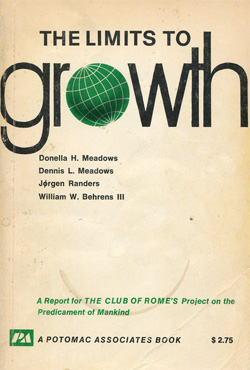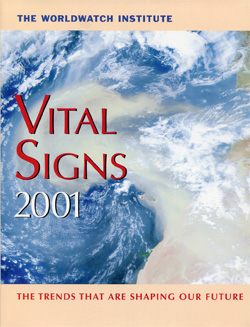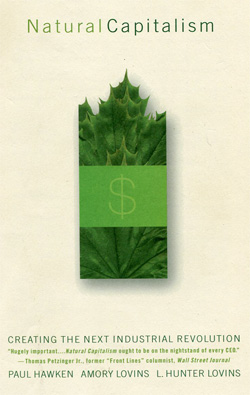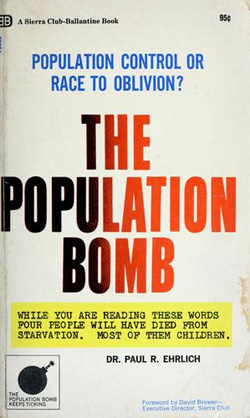
Criteria for Evaluating a Book of Non-fiction: With examples from environmentalism
Contents
1. Does the book have a clear, organized argument?
2. Does the book speak to you?
3. Is the argument an emotional or a logical one?
4. Can the book pass the two lookup tests?
5. Does the book prove its central argument is true?
Reading for pleasure is one thing, but reading for a purpose is quite another. Over the years I’ve found it useful to be able to quickly evaluate a book for its potential usefulness. Here is a simple way to do that for nonfiction, using a handful of questions:
1. Does the book have a clear, organized argument?
 The argument may be simple, such as the one in Our Ecological Footprint that says the ecological footprint is a good measure of the sustainability of civilization. Or it may be complex, such as the argument in Limits to Growth, which presents an airtight argument in the form of a computer simulation model. Even just the presentation of descriptive material is an argument, because the author is saying this is a useful and true description of something. Regardless of what the argument is, it must be presented in a clear, organized manner, so that it can be easily and correctly understood.
The argument may be simple, such as the one in Our Ecological Footprint that says the ecological footprint is a good measure of the sustainability of civilization. Or it may be complex, such as the argument in Limits to Growth, which presents an airtight argument in the form of a computer simulation model. Even just the presentation of descriptive material is an argument, because the author is saying this is a useful and true description of something. Regardless of what the argument is, it must be presented in a clear, organized manner, so that it can be easily and correctly understood.
Examine the book’s table of contents. Does it layout the structure of the author’s main argument? Or is it more of a ramble, with the core of the argument buried somewhere in the chapters? Or worse yet, is there no real argument, but just a collection of related information and opinions?
 If the table of contents passes muster, look at the preface, synopsis, introduction, or first chapter. It should present the core of what the author wants to say, in a bit more detail. In some books you may have to examine some of the ending chapters to find this.
If the table of contents passes muster, look at the preface, synopsis, introduction, or first chapter. It should present the core of what the author wants to say, in a bit more detail. In some books you may have to examine some of the ending chapters to find this.
If you cannot find the book’s main argument and understand it in a few minutes, the book is probably not going to be of much value to you.
2. Does the book speak to you?
Now that you’ve breezed through some of the key parts of the book, does it speak to you? Do you find yourself on the same wavelength as the author? Is the message coming through loud and clear? If not, you have a tough read ahead of you and may need to pass on the book.
3. Is the argument an emotional or a logical one?
Too many books present mostly an emotional argument. Some emotion is okay, so the author can transmit personality and passion, and perhaps inspire you to action. But too much emotion probably means the argument is so unsound that the author is substituting rhetoric for logic. If so, your time is better spent elsewhere.
4. Can the book pass the two lookup tests?
Years ago my brother Pete gave me some advice on how to very quickly test a book to see if it was probably going to be good or not. He said all you have to do is try two things:
First you lookup something you know a lot about, and see how correct and deep the author’s perception of it is. Then you lookup something you would like to know more about, and see how well the author helps you out there. If the book passes both tests, you have proof it is of value to you.
Now let’s assume you’ve got a copy of the book, and have read the key chapters or the whole thing. This puts you in a position to answer some even more important questions:
5. Does the book prove its central argument is true?
It should or it’s worthless. Too many books prove their argument by emotion and rhetoric. They say, in so many words, that so and so must be true and you should believe it, without ever presenting evidence why. Let’s examine some examples:
 The central argument of Al Gore’s Earth in the Balance is that the global environmental sustainability problem exists and needs to be solved by “A Global Marshall Plan” as presented in the last chapter. The plan has five strategic goals, like Stabilizing World Population and The Rapid Creation and Development of Environmentally Appropriate Technologies. The goals, why they are important, and how to reach them are described briefly.
The central argument of Al Gore’s Earth in the Balance is that the global environmental sustainability problem exists and needs to be solved by “A Global Marshall Plan” as presented in the last chapter. The plan has five strategic goals, like Stabilizing World Population and The Rapid Creation and Development of Environmentally Appropriate Technologies. The goals, why they are important, and how to reach them are described briefly.
Unfortunately, there is no proof whatsoever this approach will work. For example, Gore argues we can stabilize world population by a global demographic transition to lower population growth rates, by allocating resources to fund key programs, developing effective programs to reduce infant mortality and increase the health of children, and making birth control devices ubiquitously available. But he presents insufficient proof this will work. Specifically, he presents no evidence that anything in the plan will cause nations to commit resources to what he suggests. Overall, his five point plan comes across as a noble wish list. There is no analysis showing why these five points were chosen versus others, which makes their selection arbitrary.
 By contrast, Jared Diamond’s Guns, Germs, and Steel examined competing hypotheses and competing evidence for why Western Civilization has become the world’s dominant culture. The book is one long, cohesive, carefully reasoned, evidence based argument. It concluded that the central reason the Anglo Saxon culture of Europe and North America became dominant was not “cultural or racial differences, but rather … environmental differences powerfully amplified by various positive feedback loops.” (source)
By contrast, Jared Diamond’s Guns, Germs, and Steel examined competing hypotheses and competing evidence for why Western Civilization has become the world’s dominant culture. The book is one long, cohesive, carefully reasoned, evidence based argument. It concluded that the central reason the Anglo Saxon culture of Europe and North America became dominant was not “cultural or racial differences, but rather … environmental differences powerfully amplified by various positive feedback loops.” (source)
The error in Earth in the Balance is a common pattern, one that could be called the “we must do this” solution failure pattern. Probably over half of the solution oriented environmental literature commits this error. It presents what we should do, and implores the world to do it, but fails to address the issue that if there is no reason for the key agents in the system to do it right now, it won’t get done.
6. Does the book get to the bottom of its subject?
Non fiction is in general descriptive or prescriptive. It describes what is or what should be. To avoid wandering all over the universe, a book should stick to a single subject. To give the reader maximum value, a book should get to the bottom of its subject.
This means a book should go well past superficial and well known coverage of its subject. It needs to be reasonably complete. What it leaves out, especially to a reader who is unable to spot what’s missing, can be much more important that what it leaves in.
 Let’s take a look at a descriptive example. Each year the Worldwatch Institute publishes a medium sized book called Vital Signs. It contains high quality data and commentary on global trends, with emphasis on the environment. It is a descriptive book, because it does not attempt to explain why a trend is happening, other than at the proximate (immediate) level.
Let’s take a look at a descriptive example. Each year the Worldwatch Institute publishes a medium sized book called Vital Signs. It contains high quality data and commentary on global trends, with emphasis on the environment. It is a descriptive book, because it does not attempt to explain why a trend is happening, other than at the proximate (immediate) level.
However the Vital Signs series does not get to the bottom of even the descriptive side of its data. In 2001 I wrote the Worldwatch Institute, and asked them what they thought of adding a new type of data to the series. It would be “metadata,” which is data about data. I gave the example of a graph showing the number of unsolved environmental problems, and speculated that the graph would show a relentless increase. I argued that this graph would be far more important than the others, because it would summarize the problem of the problem symptoms as a whole. I even included a sample hypothetical graph. They replied that such data was not important.
 As a prescriptive example, consider Natural Capitalism by Paul Hawken, Amory Lovins, and L. Hunter Lovins. As former President Bill Clinton writes on the back cover, “Natural Capitalism basically proves beyond any argument that there are presently available technologies, and those just on the horizon, which will permit us to get richer by cleaning, not by spoiling, the environment.” The book painted an in depth picture of how the world economy could move to a sustainable path, by switching to better industrial practices. It was extraordinarily well received when it was published in 1999. It seemed that perhaps this was the answer, and that industry would take the lead and solve the problem.
As a prescriptive example, consider Natural Capitalism by Paul Hawken, Amory Lovins, and L. Hunter Lovins. As former President Bill Clinton writes on the back cover, “Natural Capitalism basically proves beyond any argument that there are presently available technologies, and those just on the horizon, which will permit us to get richer by cleaning, not by spoiling, the environment.” The book painted an in depth picture of how the world economy could move to a sustainable path, by switching to better industrial practices. It was extraordinarily well received when it was published in 1999. It seemed that perhaps this was the answer, and that industry would take the lead and solve the problem.
However nothing happened, because the book did not get to the bottom of its subject. It was essentially only a “technical solution.” It failed to address the “social side” of the problem. It never got to the bottom of this question: Why is the world so against adopting a solution to the problem? The book blithely assumed that by showing an attractive future in detail, corporations would take the lead and decide to move to that future. They did not, because of factors the book never addressed.
If a book doesn’t get to the bottom of its subject, or at least try to, then the waiter has delivered a glass that is half full to your table, but charged you for a full one.
7. Does the book follow the 80/20 rule?
 No book can cover its subject completely. To be effective, an article or book must focus on the 20% of the issue that makes 80% of the difference. In other words, it must dwell on what is important. More than any other criteria, this is what separates the diamonds from the dirt. A book can come up short in all the above criteria, but if it comes through on the 80/20 rule, then it may be of value anyhow. Let’s look at two examples:
No book can cover its subject completely. To be effective, an article or book must focus on the 20% of the issue that makes 80% of the difference. In other words, it must dwell on what is important. More than any other criteria, this is what separates the diamonds from the dirt. A book can come up short in all the above criteria, but if it comes through on the 80/20 rule, then it may be of value anyhow. Let’s look at two examples:
In 1968 Paul Ehrlich published The Population Bomb. The book itself was a bomb, because it forecast that “in the 1970s and 1980s hundreds of millions of people will starve to death.” This did not happen, causing many (and perhaps most) to write off Ehrlich as a crackpot.
But those who did missed the point. Population is a key factor that must be understood and managed. It is an excellent example of how, if the key factors of a complex problem are correctly identified and then resolved, then the entire problem is solved.
 In 1962 Silent Spring awoke the world to the problem of pesticides, which in turn helped lead to the beginning of the modern environmental movement. But the book did not cover the entire problem of environmental degradation. Nor did it cover the whole gamut of pesticides. Instead, it focused on mostly one pesticide, DDT.
In 1962 Silent Spring awoke the world to the problem of pesticides, which in turn helped lead to the beginning of the modern environmental movement. But the book did not cover the entire problem of environmental degradation. Nor did it cover the whole gamut of pesticides. Instead, it focused on mostly one pesticide, DDT.
What Miss Carson had found was a high leverage point in the system to push on, by following the 80/20 rule. In her case it was more like the 99/1 rule. The widespread use of DDT was the one human action that was making all the difference. It caused farmers, businessmen, government officials, and even many scientists to support the extensive, indiscriminate use of pesticides. The use of DDT, in turn, enhanced the illusion that the world did not need to not care very much at all about the heath of the biosphere.
In reality DDT was an “elixir of death” which had the potential to lead to a Silent Spring. When the use of DDT was soon banned, the illusion mentioned above was shattered, and the full truth was revealed.
Apparently we need a few more books that follow the 80/20 rule so well.
Reading time is scarce. These seven criteria should be enough for you to make the most of it. I hope they can help you as much as they have helped me.
Happy reading,
Jack Harich
June 13, 2005
This article is also available as a PDF file. However the PDF file version lacks the book cover images.
These thoughts were written up as part of an Atlanta environmental book club led by Patty Durand.

























